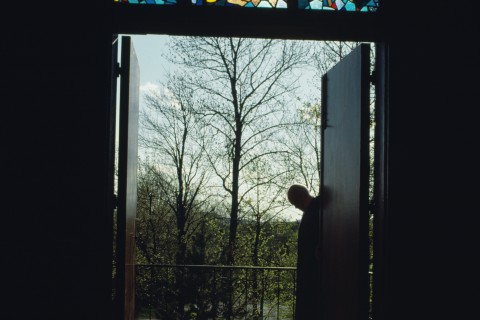Beauty and delight: Artistic humility
My mother studied painting at the New York Art Students League with Joseph Solman, the American artist who died last year at age 99. Solman was briefly a member, along with Mark Rothko, of an artistic vanguard known as The Ten, which in the 1930s rejected the literalism of American art and championed expressionism. Yet Solman remained a traditionalist among radicals, resisting the turn to abstraction. “The subject has more interest than any shape we might invent,” he said in a 1998 interview. “I take what’s out there, and that’s what lights up my imagination.”
Solman produced no religious works like the modernist Rothko Chapel, but in his attention to “what’s out there”—such as in his gouaches of sleeping subway riders—one finds something akin to religious art. It’s a matter of artistic humility, the rare quality that Solman cherished in Cézanne, and that my mother cherished in Solman.
Yet perhaps artistic humility was not always so rare. Before there was “art” in the modern, self-expressive sense, there were images whose makers were conscious of working in a public tradition. Before there was art (singular), there were arts (plural) which one mastered by imitating the masters. Before there was art as autonomous career, there was art as religious service. The churches should have been, one would think, the primary custodians of the traditional arts. But we have been passing through a philistine stage in our culture, when we prize artistic innovation but are short on true originals like Antoni Gaudí, when we long for ancient beauty in our churches but have to endure the latest “bold vision” in faceless concrete and didactic abstract forms.
For an antidote to the bold vision, I like to think of iconographers such as Orthodox priest Andrew Tregubov and his wife, Galina, who are recovering old techniques and prototypes after a period of sentimentalized adaptation, while retaining the subtle freedom and pastoral sensitivity characteristic of the best traditional icons. In icon “writing,” as in ballet, discipline comes first and personal expression follows.
Perhaps it is too soon to look for a fully naturalized Western Christian icon tradition, but impressive work is being done by a younger generation of Christian iconographers, among them the English artist David Clayton. My family and I first encountered Clayton’s work in a delightful children’s coloring book called Meet the Angels; we saw some of it again when we visited Pluscarden Abbey in Scotland, where Clayton’s luminous double-sided icon cross floats high above the stone altar. Originally headed for a career in engineering and materials science, Clayton went through a troubled atheist phase in which, as he said in a recent interview, he felt “angry at God.” It was hearing Palestrina sung at the London Oratory that first opened Clayton to the sense of God’s presence, eventually leading him to convert to Catholicism and follow the path of a full-time artist. As the saying goes, “Beauty converts.” After training in Western academic portrait painting and Byzantine iconography, Clayton began to receive commissions from churches and founded an art school in London. Last year he relocated to Thomas More College in New Hampshire to create an unusual Way of Beauty program in which undergraduates study sacred and secular art, music, mathematics and philosophy, in a curriculum designed to provide insight into the rational and moral structures that make for beauty in nature and society.
Last fall I learned of another welcome alternative to the bold vision. Two members of the Plymouth Congregational Church in Minneapolis contacted me after reading a Christian Century column I had written in memory of J. R. R. Tolkien and C. S. Lewis illustrator Pauline Baynes. They told me about a series of four vast embroideries conceived and executed to the most exacting standards by women in the congregation (the Plymouth Needlers) on designs they had commissioned from Baynes. It is an inspiring project. The first embroidery to be completed, “Churchmen in America” (1974), depicts the Pilgrims arriving in the New World, celebrating the original Thanksgiving, and founding churches and schools amid emblems of harvest and redemption. “Christmas Radiance” (1992) shows the same Plymouth settlers gazing, as if all times were present, at a group of medieval shepherds adoring the Christ child, while divine light streams down from above. A third embroidery depicts springtime renewal, and an embroidery for summer, celebrating religious freedom, is still in the making.
When I consider that each work, at 26 by 16 feet, takes some 40 Needlers nearly seven years to complete, that for more than three decades the Needlers have worked together in a multigenerational fellowship, and that the final products, whose makers wish to remain anonymous, radiate objective beauty and delight in God’s creation, I can only be hopeful for the future of religious art. For the truth remains, and will win out: beauty converts.





